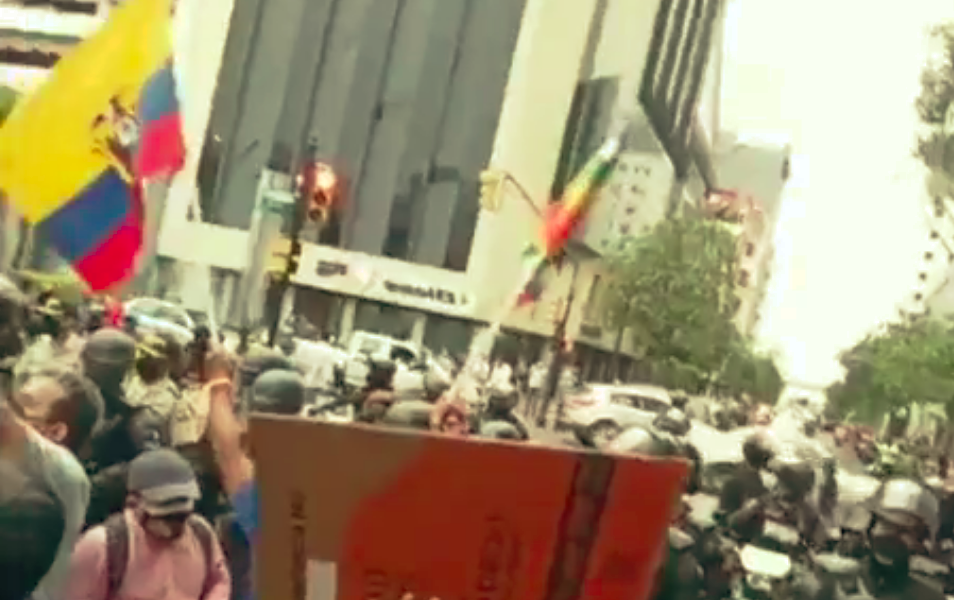RIO DE JANEIRO, BRAZIL – Indigenous people, workers, and students coincided this Tuesday in a massive protest against the government of Guillermo Lasso in Ecuador, in a day that included roadblocks and mobilizations, mainly to demand the lowering of fuel prices, and which put to the test the state of emergency in security matters that the Executive issued for the whole country.
Five months after his inauguration, Lasso faced the most critical protest because of the dimension of the roadblocks and marches and because it came at a time of multiple fronts.
Read also: Check out our coverage on Ecuador
The Confederation of Indigenous Nationalities of Ecuador (CONAIE) and the United Workers Front (FUT) were the most prominent groups marching throughout the country. Still, the National Union of Educators (UNE) and the Federation of University Students of Ecuador (FEUE), among dozens of organizations, also participated.

To the state of exception that put the military in the streets due to the wave of insecurity, Lasso added the freezing of fuel prices last week, a point demanded almost unanimously by all social sectors. Still, the decree that provided for this measure also enabled a new increase, which pushed these protests.
The President seemed to be concerned about Tuesday’s protest: in the last 24 hours, he uploaded to his Twitter account a dozen texts, all of the similar tenor and with the hashtag #DileNoalParo, in which he questioned the blocking of roads and streets.
The official spokesman of the Government, Carlos Jijón, remarked that “the working activities of the country” developed “with relative tranquility” due to the work of the Public Force which prevented the closing of roads.
Jijón pointed out that the government kept “its hands open for a dialogue with all sectors, respecting the right to protest peacefully and guaranteeing that the disagreement of certain sectors, such as mobilizations, are carried out within the framework of the law.”
Although Jijón detailed that only six roads had been blocked and 18 people arrested, both figures were difficult to confirm: many of the blockades were sporadic and brief, and the organizations reported more arrests, in some cases also for a short time.
In its social networks, Conaie denounced “police and military repression” in Cotopaxi and Imbabura, and its head, Leonidas Iza – who was in Saquisili – reported seven protesters arrested in Guayas, one in Sucumbios and one in Cotopaxi.
“Here we are here to claim rights, we are not internal enemies for you to declare war on us; listen, president: we are all living this poverty, including the fiscal coffers, but we cannot take money from the poorest people, but freeze (fuels) at the prices proposed and go to a more comprehensive discussion on the targeting policy,” warned Iza in his speech.
“The wealthy sectors should be the ones to pay for fuels without subsidies and not go out to insult the demonstrators”, added the leader, according to the newspaper El Comercio.
The website Primicias reported a spattering of road blockades in large parts of the country, with burning tires, crossed trees, and stones.
In Quito, meanwhile, the police cordoned off all accesses to the Carondelet Palace, the seat of government, in a radius of hundreds of meters around, with two rows of agents behind interlocking fences.
And closer to the Government Palace, less than 100 meters away, were the Armed Forces, with particular groups.
Leaders and activists of the FUT, the teachers’ union, and other associations and organizations marched through the capital’s historic center.
The President of the FUT, Mesias Tatamuez, said that the main request was the repeal of the decree that froze fuel prices but only after increasing them, and assessed that the values should, yes, be frozen but at the level before the decrees.
The native peoples already showed 2019 signs of their mobilization capacity when they led the fight against eliminating fuel subsidies.
On Saturday, the gallon (the measure used in the country, equivalent to 3.8 liters) of diesel went to 1.90 dollars compared to one dollar it cost more than a year ago, and common naphtha climbed to 2.55 dollars.
The protests took place under a 60-day state of emergency decreed a week ago, which ordered the presence of the military in the streets to support the police in the fight against crime, and the government did not suspend the freedom to demonstrate or assemble, despite being authorized to do so.
“The stoppage represents economic losses for small businesses, which are the livelihood of thousands of Ecuadorian families and households. Say #NoAlParo, for the reactivation and prosperity of the entire country,” Lasso wrote on Twitter.
In another message, he stressed: “The reactivation is already underway. Ecuadorians seek to move forward, live in peace, and grow in a country of opportunities, without paralyzations.”
In another message, he also relied on a job creation figure that his government usually shows: “For those 275,000 Ecuadorians who finally got a job: let’s let them work. Ecuador is a country of working people. The strikes affect the economy of thousands of families and truncate development at a national level.”

